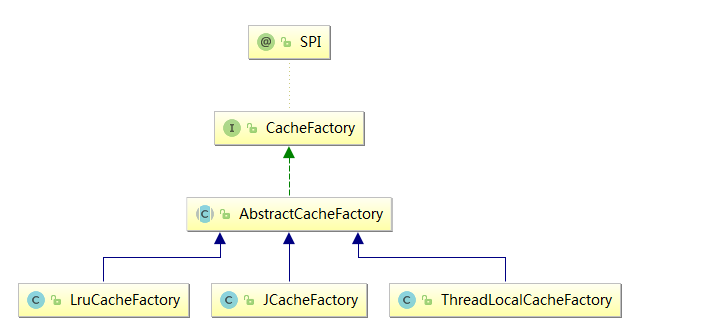The main implementation of dubbo cache, the cache of method call results.
The use of caching can be configured on both the service consumer and the provider.
Taking the consumer as an example, you can configure a global cache policy so that all service references start caching
<dubbo:consumer cache="lru"/>
You can configure a cache policy for a service reference
<dubbo:reference id="demoService" interface= "demo.dubbo.api.DemoService" cache="lru" >
also supports enabling caching strategy for a single method
<dubbo:reference id="demoService" interface="demo.dubbo.api.DemoService" >
<dubbo:method name= "sayHello" cache="lru"> </dubbo:method>
</dubbo:reference>
The server configuration method is the same.
The specific implementation process is analyzed below
Dubbo's cache is implemented through filters.
Through this blog post, I understand the annotation Activate, as well as the use of cache configuration cache
. Here I found the corresponding Filter implementation CacheFilter
//Activate指明服务方和消费方都可以启用缓存
@Activate(group = {Constants.CONSUMER, Constants.PROVIDER}, value = Constants.CACHE_KEY)
public class CacheFilter implements Filter {
private CacheFactory cacheFactory;
public void setCacheFactory(CacheFactory cacheFactory) {
this.cacheFactory = cacheFactory;
}
public Result invoke(Invoker<?> invoker, Invocation invocation) throws RpcException {
if (cacheFactory != null && ConfigUtils.isNotEmpty(invoker.getUrl().getMethodParameter(invocation.getMethodName(), Constants.CACHE_KEY))) {
//invoker.getUrl().addParameter(Constants.METHOD_KEY, invocation.getMethodName())
//作为缓存对象的key 可知不同的服务提供者,每个方法都会单独分配一个缓存对象
Cache cache = cacheFactory.getCache(invoker.getUrl().addParameter(Constants.METHOD_KEY, invocation.getMethodName()));
if (cache != null) {
//方法的参数作为key
String key = StringUtils.toArgumentString(invocation.getArguments());
if (cache != null && key != null) {
Object value = cache.get(key);
if (value != null) {
//缓存命中,直接返回,也就是说,
//这里要注意,如果有多个过滤器,cache后面的过滤器不会执行
return new RpcResult(value);
}
Result result = invoker.invoke(invocation);
if (!result.hasException()) {
cache.put(key, result.getValue());
}
return result;
}
}
}
return invoker.invoke(invocation);
}
}
Regarding the implementation of cacheFactory, here is a look at the CacheFactory$Adaptive source code dynamically generated by dubbo
public class CacheFactory$Adaptive implements com.alibaba.dubbo.cache.CacheFactory {
public com.alibaba.dubbo.cache.Cache getCache(com.alibaba.dubbo.common.URL arg0) {
if (arg0 == null)
throw new IllegalArgumentException("url == null");
com.alibaba.dubbo.common.URL url = arg0;
//默认是 lru 缓存策略
String extName = url.getParameter("cache", "lru");
if(extName == null) throw new IllegalStateException("Fail to get extension(com.alibaba.dubbo.cache.CacheFactory) name from url(" + url.toString() + ") use keys([cache])");
com.alibaba.dubbo.cache.CacheFactory extension = (com.alibaba.dubbo.cache.CacheFactory)ExtensionLoader.getExtensionLoader(com.alibaba.dubbo.cache.CacheFactory.class).getExtension(extName);
return extension.getCache(arg0);
}
}There are three specific implementations of CacheFactory provided by duobb. The class diagram is as follows

The abstraction parent class of AbstractCacheFactory defines the method getCache of the cache object.
public abstract class AbstractCacheFactory implements CacheFactory {
private final ConcurrentMap<String, Cache> caches = new ConcurrentHashMap<String, Cache>();
public Cache getCache(URL url) {
String key = url.toFullString();
Cache cache = caches.get(key);
if (cache == null) {
caches.put(key, createCache(url));
cache = caches.get(key);
}
return cache;
}
//具体缓存实现在子类中,这也是dubbo一贯的设计模式,公共方法提到抽象类中
protected abstract Cache createCache(URL url);
}//LruCacheFactory子类,返回LruCache对象,实现LRU策略缓存
public class LruCacheFactory extends AbstractCacheFactory {
protected Cache createCache(URL url) {
return new LruCache(url);
}
}
//JCacheFactory子类,返回LruCache对象,可与符合JSR107规范的缓存桥接
public class JCacheFactory extends AbstractCacheFactory {
protected Cache createCache(URL url) {
return new JCache(url);
}
}
//ThreadLocalCacheFactory子类,返回LruCache对象,ThreadLocal利用当前线程缓存
public class ThreadLocalCacheFactory extends AbstractCacheFactory {
protected Cache createCache(URL url) {
return new ThreadLocalCache(url);
}
}The three Cache object classes mentioned above all implement the com.alibaba.dubbo.cache interface. The class diagram is as follows,

Cache interface is very simple
public interface Cache {
//put value到缓存
void put(Object key, Object value);
//通过key 获取value
Object get(Object key);
}All three Cache classes are implemented and it is worth learning
the LruCache class
public class LruCache implements Cache {
private final Map<Object, Object> store;
public LruCache(URL url) {
//从配置中,获取cache大小
final int max = url.getParameter("cache.size", 1000);
//内部是LRUCache对象
this.store = new LRUCache<Object, Object>(max);
}
public void put(Object key, Object value) {
store.put(key, value);
}
public Object get(Object key) {
return store.get(key);
}
}Analyzing the LRUCache source code, we can see that LRUCache inherits LinkedHashMap, and LinkedHashMap is a doubly linked list, which is a natural lru data structure.
As long as the LinkedHashMap is defined, it is ordered, such as the definition of the constructor of LRUCache.
public LRUCache(int maxCapacity) {
//默认有序的链表,初始数组申请空间大小16,负载因子0.75(触发扩展的填充度临界值)
super(16, DEFAULT_LOAD_FACTOR, true);
this.maxCapacity = maxCapacity;
}And override the removeEldestEntry method of LinkedHashMap
@Override
//定义换出缓存对象的条,这里是大小超过最大容量
protected boolean removeEldestEntry(java.util.Map.Entry<K, V> eldest) {
return size() > maxCapacity;
}In this way, the creation of an LRU cache container can be completed. The specific implementation can read and write the LinkedHashMap source code.
ThreadLocalCache class implementation
public class ThreadLocalCache implements Cache {
//通过ThreadLocal把store 绑定到当前线程
private final ThreadLocal<Map<Object, Object>> store;
public ThreadLocalCache(URL url) {
this.store = new ThreadLocal<Map<Object, Object>>() {
@Override
protected Map<Object, Object> initialValue() {
return new HashMap<Object, Object>();
}
};
}
public void put(Object key, Object value) {
store.get().put(key, value);
}
public Object get(Object key) {
return store.get().get(key);
}
}JCache class implementation
public class JCache implements com.alibaba.dubbo.cache.Cache {
private final Cache<Object, Object> store;
public JCache(URL url) {
String method = url.getParameter(Constants.METHOD_KEY, "");
//每个服务提供者每个方法,分配一个cache对象
String key = url.getAddress() + "." + url.getServiceKey() + "." + method;
// jcache 为SPI实现的全限定类名
String type = url.getParameter("jcache");
//通过CachingProvider 等jsr107规范相关接口 操作,这样,就能通过购spi 机制桥接各种缓存实现了
CachingProvider provider = type == null || type.length() == 0 ? Caching.getCachingProvider() : Caching.getCachingProvider(type);
CacheManager cacheManager = provider.getCacheManager();
Cache<Object, Object> cache = cacheManager.getCache(key);
if (cache == null) {
try {
//configure the cache
MutableConfiguration config =
new MutableConfiguration<Object, Object>()
.setTypes(Object.class, Object.class)
//通过cache.write.expire 设置失效时间,默认为1分钟,但不知道cache.write.expire在哪设置的??
.setExpiryPolicyFactory(CreatedExpiryPolicy.factoryOf(new Duration(TimeUnit.MILLISECONDS, url.getMethodParameter(method, "cache.write.expire", 60 * 1000))))
.setStoreByValue(false)
.setManagementEnabled(true)
.setStatisticsEnabled(true);
cache = cacheManager.createCache(key, config);
} catch (CacheException e) {
// 初始化cache 的并发情况
cache = cacheManager.getCache(key);
}
}
this.store = cache;
}
public void put(Object key, Object value) {
store.put(key, value);
}
public Object get(Object key) {
return store.get(key);
}
}